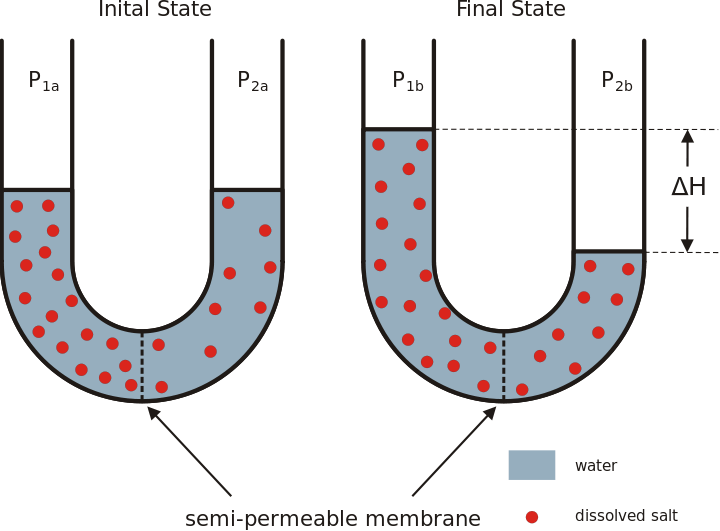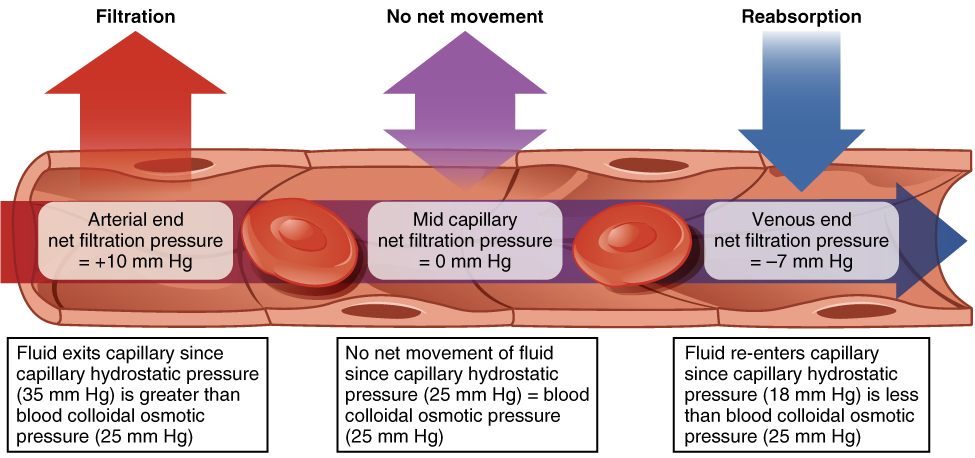Difference Between Osmotic pressure and Oncotic pressure
Key Difference – Osmotic pressure vs Oncotic pressure
Osmotic pressure and oncotic pressure are two important aspects of physiology that help explain the movement of solute and solvent molecules into and out of the blood capillary system, though there is a distinct difference between these two terms. They are important in bringing about the exchange of nutrients between blood and tissue components of the body. Osmotic pressure and oncotic pressure are both referred to as ‘Starling’s forces’ in physiology. The key difference between them is that Osmotic pressure is the pressure developed by solutes dissolved in water working across a selectively permeable membrane while Oncotic pressure is a part of the osmotic pressure created by the larger colloidal solute components.To understand the difference between both these forces, we shall first take a look at what they are and then how they help in our physiology.
What is Osmotic pressure?
Osmotic pressure is the pressure required to prevent ‘osmosis’. Osmosis is the process where solvent molecules, such as water, in a solution tend to move from a region of low solute concentration to a region of high solute concentration across a semi-permeable membrane i.e. a membrane that is impermeable to the solute molecules but permeable to solvent molecules.Specifically, osmotic pressure is the pressure exerted by the solute molecules preventing the movement of solvent molecules from a region of low solute concentration to a region of high solute concentration across a semi-permeable membrane. Osmotic pressure is also called hydrostatic pressure, and it depends on the concentration of solute molecules on either side of the semi-permeable membrane.
What is Oncotic pressure?
Oncotic pressure is a part of the osmotic pressure, particularly in biological fluids such as plasma. Oncotic pressure is exerted by colloids or, in other words, proteinaceous macromolecules of the plasma like albumin, globulin, and fibrinogen. Oncotic pressure is therefore also called ‘colloid osmotic pressure.’ Albumin is the most abundant of all three proteins and contributes to around 75% of the exerted oncotic pressure. The total osmotic pressure of blood plasma is known to be 5535 mmHg, and the oncotic pressure accounts for around 0.5% of it i.e. around 25 to 30 mmHg.
Osmotic pressure and oncotic pressure are also known as Starling’s forces. Both these forces together govern the passive directional movement of water and nutrients of the plasma out of the capillaries and into the interstitial fluid (at the arterial end) as well as vice versa (at the venous end); this phenomenon constitutes Starling’s principle of transvascular fluid dynamics. Both of these forces work differently at both the arterial and venous ends of the capillary bed to bring about the proper exchange of water and nutrients in the tissue. At the arterial end of the capillary bed, the osmotic pressure is higher than the oncotic pressure within the capillaries, hence water and nutrients move out of the capillaries into the interstitial fluid, conversely, at the venous end , the osmotic pressure is lower than the oncotic pressure within the capillaries and water is reabsorbed into the capillaries from the interstitial fluid. Hence, both osmotic and oncotic pressure serve as important forces in blood circulation.

Filtration and re-absorption present in capillaries.
What is the difference between Osmotic Pressure and Oncotic Pressure?
Definition of Osmotic Pressure and Oncotic Pressure
Osmotic pressure: Osmotic pressure is the pressure exerted to prevent the movement of free solvent molecules across a semi-permeable membrane into a region of high solute concentration.
Oncotic pressure: Oncotic pressure is the pressure exerted by colloidal plasma proteins to reabsorb water back into the blood system.
Characteristics of Osmotic Pressure and Oncotic Pressure
Function
Osmotic pressure: the osmotic pressure prevents the movement of water across the membrane from a region of high solute concentration to a region of low solute concentration.
Oncotic pressure: Oncotic pressure reabsorbs and moves water across a membrane from a region of high solute concentration to a region of low solute concentration.
Molecules
Osmotic pressure: It is exerted by low molecular weight molecules (small proteins, ions, and nutrients)
Oncotic pressure: It is exerted by large molecular weight molecules (plasma proteins with Mw > 30000)
Image Courtesy: “Osmose en” by © Hans Hillewaert / (CC BY-SA 3.0) via Wikimedia Commons “2108 Capillary Exchange” by OpenStax College – Anatomy & Physiology, Connexions Web site. http://cnx.org/content/col11496/1.6/, Jun 19, 2013.. (CC BY 3.0) via Wikimedia CommonsncG1vNJzZmivp6x7pbXFn5yrnZ6YsqOx07CcnqZemLyue8OinZ%2Bdopq7pLGMm5ytr5Wau2670qamraGTYr2zsdKsrKudXZa7pXnVrGSoppOkwaqvjKmpnqujqr%2Bmew%3D%3D